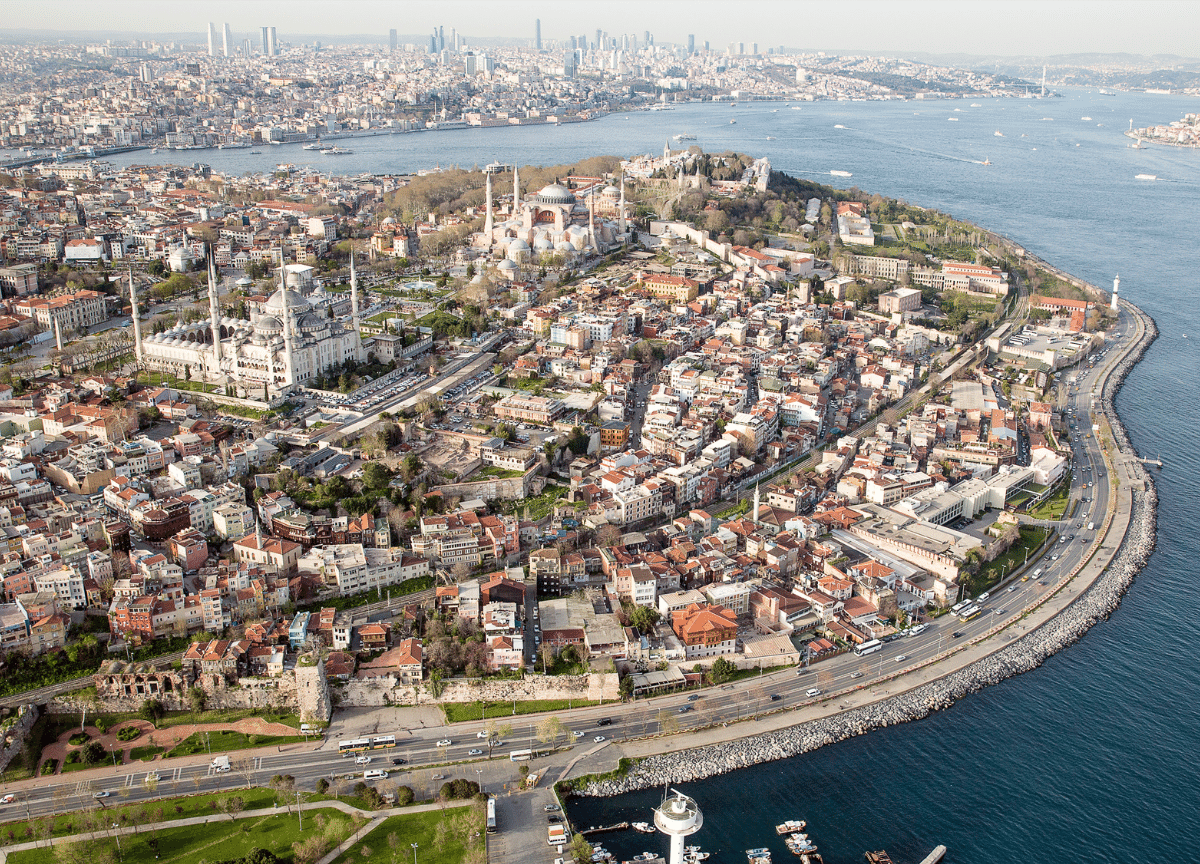Top 15 Places to Visit in Sultanahmet

Istanbul's so-called "Historical Peninsula" is an extremely rich region in terms of tourism. Sultanahmet, the oldest district of Istanbul, welcomes hundreds of thousands of tourists throughout the year. In this article, we present you with a list of historical places you should see in Sultanahmet when you come to Istanbul.
List of Places to Visit in Sultanahmet
Sultanahmet region; It is a region that was the center of the Byzantine and then the Ottoman Empire. It has been home to emperors and sultans for centuries. You will feel yourself in history while visiting this region where the fate of empires took place. We have prepared our list of places to visit in Sultanahmet to help you with this place.
1- Sultanahmet Square
Sultanahmet Square was used as a hippodrome during the Byzantine Empire. Events such as chariot horse races were held here for many years. It was one of the biggest arena squares of Constantinople. Later, the Ottoman Empire also used this area as the Hippodrome Square.
Sultanahmet Square is one of the most important squares in Istanbul even today. There are many historical monuments and places in the square. One of them is the German Fountain, which was built in Germany and moved here piece by piece. Inaugurated in 1901, the fountain has eight columns and its exterior is decorated with tiles. This fountain is usually the starting point of Sultanahmet excursions.
Before you start touring Sultanahmet square, you might want to recharge your batteries at one of the great restaurants in the area. You can take a nice break at Deraliye Terrace Restaurant. You can enjoy the panoramic view of Sultanahmet Square at Deraliye Terrace.
2- Theodosius Obelisk, Serpent Column, and Knitted Column
Sultanahmet Square is home to three columns from the time when it was a hippodrome. All three of these columns are so majestic and intriguing that they are literally impossible to miss.
Made of granite, the Theodosius Obelisk was brought from Egypt and placed in the hippodrome by Emperor Theodosius in 390 AD. However, the construction of the obelisk is thought to date back to the 15th century BC.
The Serpent Column, located a little further south of the square, was built in 479 BC in the ancient Greek city of Delphi. The column is made of bronze and depicts three snakes entangled with each other.
The Knitted Column at the southernmost end of the square is the obelisk about which we have the least information. The oldest information about the obelisk is that it was repaired by Constantine VII in the 10th century.
3- Blue Mosque
The Blue Mosque was built by the Ottoman Sultan Ahmet I between 1609-1617 by the architect Sedefkâr Mehmed Aga. It is one of the most important mosques in Istanbul. It can also be considered the largest and most important historical building in Istanbul with its complex.
The mosque is decorated with Iznik tiles in different colors, but mostly blue. This is why it is known worldwide as the Blue Mosque. The complex included madrasahs, arasta, shops, baths, fountains, fountains, mausoleums, healing centers, and imarethane, although some of them have not survived to the present day.
The mosque with 6 minarets is one of the most important buildings in Sultanahmet Square. Entrance to the mosque is free of charge. Some dress code rules must be followed at the entrance.
4- Hagia Sophia Mosque
While preparing a list of places to visit in Sultanahmet, of course, it is necessary to mention the most important historical structure of Istanbul.
Hagia Sophia was built as a church by the Byzantine Emperor Justinian I between 532-537. It is a work built after 2 different churches built in the same place before.
Hagia Sophia was used as a church for centuries and witnessed dozens of natural disasters, wars, and rebellions. With the Ottoman conquest of Istanbul, Mehmet the Conqueror attached great importance to this place. Hagia Sophia, which was renovated and additions such as minarets and madrasahs were made, was converted into a mosque.
On November 24, 1934, Hagia Sophia was converted into a museum by the decision of the Council of Ministers and started to serve as a mosque again in 2020.
Hagia Sophia Mosque, one of the most valuable treasures of Istanbul and one of the most important historical and touristic structures, continues to host millions of tourists from all over the world.
Entrance to Hagia Sophia Mosque is free of charge.
5- Basilica Cistern
One of the most magnificent historical monuments of Istanbul is the Basilica Cistern, also called the Basilica Cistern.
When this cistern was first built (6th century) to store the water needed by Istanbul, it was called Basilica Cistern because it was located under a basilica. Since the 336 high columns inside created a majestic atmosphere, it became known as Yerebatan Palace among the people. And over time, the name was updated as Basilica Cistern.
140 meters long and 70 meters wide, the cistern has a water storage capacity of 100 thousand tons.
The Basilica Cistern is one of the most popular tourist attractions in the city today, as well as hosting various concerts and events.
6- Topkapi Palace
Topkapi Palace, which hosted the sultans for a long time in the Ottoman Empire and was the administrative center of the state, is one of the buildings that still preserves the splendor of the first day.
Built between 1460 and 1478 by Sultan Mehmet the Conqueror, the palace was not actually completed in one go, and various buildings continued to be added to it until the 19th century.
Topkapı Palace, which was the seat of government and the official residence of the sultans from Sultan Mehmet the Conqueror to the 31st sultan Sultan Abdülmecit, continued to host until the administration was moved to Dolmabahçe Palace in the 19th century. However, it has never lost its spiritual importance and has been transformed into a museum, constantly preserved and renovated.
Topkapı Palace has four courtyards, namely Alay Square, Divan (Justice) Square, Enderun Square, and Fourth Square. In the outer courtyards, there are places such as churches, mints, hospitals, and warehouses, while in the inner courtyards, there are places such as the Chamber of Arz, Has Room, Harem Department, Enderun Treasury, and Palace School.
7- Gulhane Park
Gülhane Park, which was built to grow roses for the palace and used as the outer gardens of Topkapı Palace for four centuries, was turned into a park in 1912 and made available for the use of the entire city.
With its gardens, pools, relaxation areas, open-air cafes, and in some places, a unique view of the Bosphorus, Gülhane Park is one of the ideal places to stop and breathe on a pleasant Sultanahmet trip.
The Museum of Islamic Science and Technology in the park is also worth a visit.
8- Hagia Irene Museum
We can say that Hagia Irene is a place of firsts. It is the first church of Byzantium and the first museum of the Ottoman Empire. Built-in 330 AD as the first church of Byzantium, Hagia Irene withstood various fires and wars. It burned down twice and was rebuilt.
The church in the first courtyard of Topkapı Palace was converted into a museum in 1846 and became the first museum of the Ottoman Empire. After being used as such for a while, the artifacts inside were moved to the Tiled Pavilion. Today, the museum often hosts concerts and artistic events.
9- Istanbul Archaeology Museum
The Istanbul Archaeological Museum, which has a rich collection of artifacts ranging from prehistoric times to the Ottoman period, including ancient sculptures and sarcophagi, is one of the most important art stops of a Sultanahmet trip. With nearly 1 million artifacts in its collection, it has taken its place among the few museums in the world.
Founded at the end of the 19th century by Osman Hamdi Bey, the museum is also the first building in Turkey to be built for the purpose of being a museum.
10- Museum of Turkish Islamic Art
Opened in 1914 in the Imaret Building in the Süleymaniye Mosque Complex, one of the most important works of Mimar Sinan, and moved to its current location, the İbrahim Paşa Palace, in 1983, the Museum of Turkish Islamic Art is one of the rare examples of its kind.
The museum exhibits rare artifacts from the Mamluk, Abbasid, Seljuk, and Ottoman periods, and the artifacts were collected from various parts of Islamic Geography. The museum also has the richest carpet collection in the world. In addition to carpets, other artifacts include stone and terracotta artifacts, ceramic and glass objects, manuscripts, and gold artifacts.
11- Hürrem Sultan Hamam (Haseki Hamam)
Located between the Hagia Sophia Museum and the Blue Mosque, the Haseki Hammam was built by Mimar Sinan for Hürrem Sultan in 1556 - 2557. The bath was built on the site of a Roman bath that was completely destroyed in 532.
The Haseki Hammam, which is divided into women's and men's sections, these sections consist of three sections: coldness, warmth, and warmth.
Although the Hürrem Sultan Bath is a museum, today it operates as a touristic bath, and carpets and rugs are also sold inside.
12- Soğukçeşme Street
Soğukçeşme Street between Topkapı Palace and Hagia Sophia Mosque is a very photogenic street with its restored two-story houses.
This street of light-colored wooden houses with bay windows is closed to vehicular traffic. The houses are lined up against the wall of Topkapi Palace and the facade faces the Hagia Sophia Mosque. Most of the houses are now serving as hostels and hotels.
Most travelers come here not only to see the street but also to take Instagram-worthy photos.
13- Cağaloğlu Hamam
Built-in 1741, Cağaloğlu Hamam is one of the most beautiful examples of Baroque architecture in the Ottoman Empire. And after this date, no new baths were built in the Ottoman Empire for a long time.
In 2003, Cağaloğlu Hammam was selected as one of the three best baths in the world and today it serves as a touristic bath.
14- Arasta Bazaar
Located behind the Blue Mosque on Torun Street, Arasta Bazaar, once known as the Sipahiler Bazaar, today consists of shops selling carpets, rugs, and souvenirs on a narrow street.
15- III. Sultan Ahmet Fountain
Built in 1728, the III. Sultan Ahmet Fountain, where Rococo-style architecture is adorned with Ottoman inspirations, is located between Topkapi Palace and Hagia Sophia Mosque. Built by architect Ahmet Aga, the fountain replaced a Byzantine fountain named Perayton.
Although it is one of the last stops on the list of places to visit in Sultanahmet, we recommend you not to pass by without seeing the fountain, which is an important historical monument.


